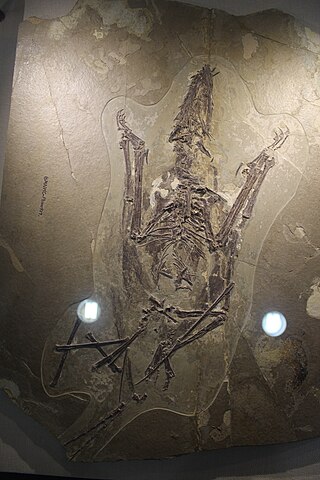
John Robert Horner is an American paleontologist most famous for describing Maiasaura, providing the first clear evidence that some dinosaurs cared for their young. In addition to his paleontological discoveries, Horner served as the technical advisor for the first five Jurassic Park films, had a cameo appearance in Jurassic World, and served as a partial inspiration for one of the lead characters of the franchise, Dr. Alan Grant. Horner studied at the University of Montana, although he did not complete his degree due to undiagnosed dyslexia, and was awarded a Doctorate in Science honoris causa. He retired from Montana State University on July 1, 2016, although he claims to have been pushed out of the Museum of the Rockies after having married an undergraduate student and now teaches as a Presidential Fellow at Chapman University.

Camarasaurus was a genus of quadrupedal, herbivorous dinosaurs and is the most common North American sauropod fossil. Its fossil remains have been found in the Morrison Formation, dating to the Late Jurassic epoch, between 155 and 145 million years ago.

The Middle Jurassic is the second epoch of the Jurassic Period. It lasted from about 174.1 to 161.5 million years ago. Fossils of land-dwelling animals, such as dinosaurs, from the Middle Jurassic are relatively rare, but geological formations containing land animal fossils include the Forest Marble Formation in England, the Kilmaluag Formation in Scotland, the Calcaire de Caen of France, the Daohugou Beds in China, the Itat Formation in Russia, the Tiouraren Formation of Niger, and the Isalo III Formation of western Madagascar.

Scaphognathus was a pterosaur that lived around Germany during the Late Jurassic. It had a wingspan of 0.9 m (3 ft).

Gyposaurus is a genus of basal sauropodomorph dinosaur from the early Jurassic of South Africa. It is usually considered to represent juveniles of other prosauropods, but "G." sinensis is regarded as a possibly valid species.

Tanycolagreus is a genus of coelurosaurian theropod from the Late Jurassic of North America.

Hesperornithoides is a genus of troodontid theropod dinosaur that lived in North America during the Late Jurassic period.
Lissoceras is an involute, smooth or finely vetrolaterally ribbed, ammonite with a blunt, un-keeled venter, included in the Haploceratidae, that lived from the Lower Bajocian - Middle Oxfordian in what is now Europe, south Asia, and southern Alaska.

Brachyrhinodon is an extinct genus of sphenodontian from the Late Triassic Lossiemouth Sandstone of Scotland.
Austropleuropholis is an extinct genus of freshwater ray-finned fish that lived during the Late Jurassic. It contains a single species, A. lombardi, from the Kimmeridigian of the Democratic Republic of the Congo, from the terrestrial/freshwater series of the Stanleyville Formation.

Ainia is an extinct genus of prehistoric ray-finned fish that lived during the Kimmeridgian stage of the Late Jurassic epoch. It contains a single species, A. armata, known from the famous Solnhofen Limestone of Germany. It is a distant relative of the bowfin, although it is more closely related to genera such as Caturus and Osteorachis.

Saurorhynchus is an extinct genus of carnivorous bony fish that lived during the Early and Middle Jurassic epochs. Fossils have been found in Europe and North America (Canada). It is commonly found in pelagic and lagoonal deposits, but mostly marine. Largest specimens can grow up to 1.9 metres (6.2 ft).
Notoemys is an extinct genus of platychelyid turtle known from the Late Jurassic and Early Cretaceous of the Americas.

Fenghuangopterus is a genus of basal pterosaur that lived in northeastern China during the Middle Jurassic.
Creniceras is a rather small Upper Jurassic ammonite with a shell in the range of about 1.6 cm in diameter,(about 1/2 in). The shell of Creniceras is eccentrically coiled, compressed, and generally smooth, except for a median row of cockscomb serrations on the body chamber and the possibility of blunt ribbing on the sides.

Lytoceratidae is a taxonomic family of ammonoid cephalopods belonging to the suborder Lytoceratina, characterized by very evolute shells that generally enlarge rapidly, having whorls in contact but mostly overlapping very sightly, or not at all.

Megapnosaurus is an extinct genus of coelophysid theropod dinosaur that lived approximately 188 million years ago during the early part of the Jurassic Period in what is now Africa. The species was a small to medium-sized, lightly built, ground-dwelling, bipedal carnivore, that could grow up to 2.2 m (7.2 ft) long and weigh up to 13 kg (29 lb).
Montirictus is an extinct genus of tritylodonts known from the Early Cretaceous Kuwajima Formation of Japan. It was among the latest surviving tritylodontids, and is closely related to the earlier Xenocretosuchus from mainland Asia, and the Jurassic Stereognathus from the UK. It may be a species of the genus Stereognathus, but resolution of its affinities conditions upon the discovery of additional material.

Oceanotitan is a genus of sauropod dinosaur known from the Upper Jurassic Lourinha Formation of Portugal. It is represented by a single specimen consisting of several tail vertebrae and appendicular bones. It contains one species, Oceanotitan dantasi. Oceanotitan is classified as possibly one of the earliest members of the Somphospondyli, a group of sauropods that includes the titanosaurs.

Yvridiosuchus is an extinct genus of machimosaurid crocodyliform from the Middle Jurassic (Bathonian) Cornbrash Formation of England and the Sommet de la Grande Oolithe, Calvados, France. The type and only known species is Y. boutilieri. Yvridiosuchus is the oldest known member of Machimosaurini, a clade of large, predatory machimosaurids with powerful jaws and teeth. Yvridiosuchus was named on the basis that it has characteristics of both earlier machimosaurids and the derived machimosaurins, such as conical, blunt teeth. It co-existed with the more generalist machimosaurid Deslongchampsina.














